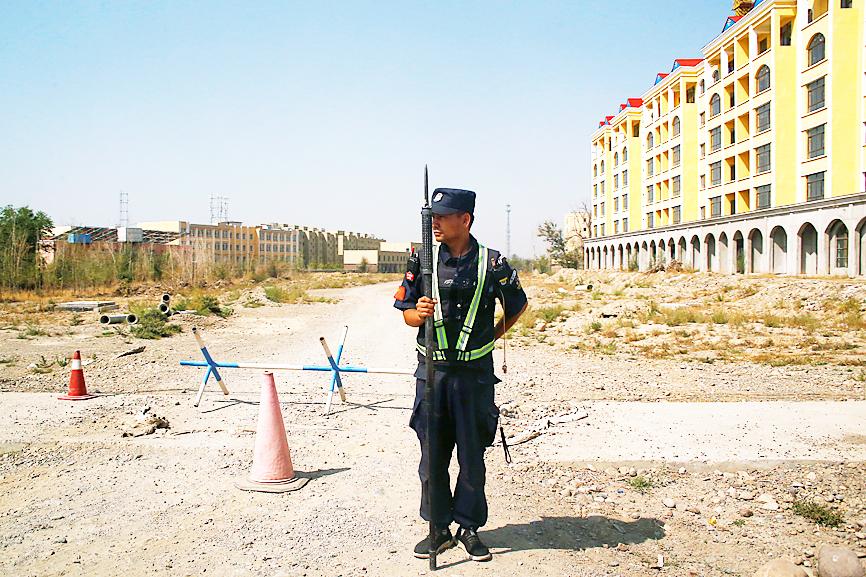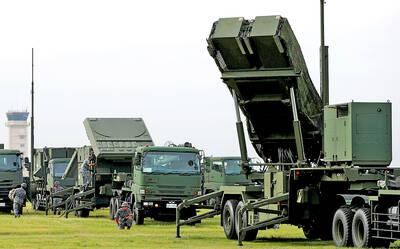Muslims in China’s Xinjiang were “arbitrarily” selected for arrest by a computer program that flagged suspicious behavior, rights campaigners said yesterday, in a report detailing big data’s role in repression in the restive region.
The US-based Human Rights Watch (HRW) said leaked police data that listed more than 2,000 detainees from the Aksu Prefecture was further evidence of “how China’s brutal repression of Xinjiang’s Turkic Muslims is being turbocharged by technology.”
Beijing has come under intense international criticism over its policies in the resource-rich territory, where rights groups say as many as 1 million Uighurs and other mostly Muslim minorities have been held in internment camps.

Photo: Reuters
China defends the facilities as vocational training centers aimed at stamping out terrorism and improving employment opportunities.
Surveillance spending in Xinjiang has ballooned in the past few years, with facial recognition, iris scanners, DNA collection and artificial intelligence deployed across the region in the name of preventing terrorism.
HRW said it had obtained the list — which detailed detentions from mid-2016 to late 2018 — from an anonymous source that had previously provided audiovisual content taken from inside a facility in Aksu.
The group gave an example of a “Mrs T” — detained for “links with sensitive countries” — who was listed as having received a number of calls from a foreign number that belonged to her sister.
HRW researchers spoke to the woman and learned that police had interrogated her sister in Xinjiang, but she has had no direct contact with her family in the region since.
The people were flagged using a program called the Integrated Joint Operations Platform, which collected data from surveillance systems in Xinjiang, before officials decided whether to send them to camps, HRW said.
The group said its research suggests the “vast majority” of people were flagged to authorities for legal behavior, including phone calls to relatives abroad, having no fixed address or switching off their phone repeatedly.
Only about 10 percent of the people on the list were detained for terrorism or extremism.
The list, parts of which were shown to reporters, described the reason for detention of many of the people as simply being “flagged” by the integrated platform.
HRW has not published the full contents of the list, citing safety concerns for the whistle-blower.
Chinese Ministry of Foreign Affairs spokesman Zhao Lijian (趙立堅) yesterday accused HRW of “stirring up trouble,” saying the report was “not worth refuting.”
Separately, US-based surveillance research firm IPVM said in a report on Tuesday that Chinese telecoms giant Huawei Technologies Co (華為) had been involved in testing facial recognition software that could send alerts to police when it recognized Uighur minorities’ faces.
An internal Huawei report cited by IPVM — which has been removed from the company’s Website, but is still visible in Google searches — showed the software as passing tests for “Uighur alerts” and “recognition based on age, sex, ethnicity, angle of facial images.”
Huawei yesterday said that the program “has not seen real-world application” and that it “only supplies general-purpose products for this kind of testing.”

MILITARY BOOST: The procurement was planned after Washington recommended that Taiwan increase its stock of air defense missiles, a defense official said yesterday Taiwan is planning to order an additional four PAC-3 MSE systems and up to 500 missiles in response to an increasing number of missile sites on China’s east coast, a defense official said yesterday. The official, who spoke on condition of anonymity, said that the proposed order would be placed using the defense procurement special budget, adding that about NT$1 trillion (US$32,88 billion) has been allocated for the budget. The proposed acquisition would include launchers, missiles, and a lower tier air and missile defense radar system, they said The procurement was planned after the US military recommended that Taiwan increase

POLITICAL AGENDA: Beijing’s cross-strait Mid-Autumn Festival events are part of a ‘cultural united front’ aimed at promoting unification with Taiwan, academics said Local authorities in China have been inviting Taiwanese to participate in cross-strait Mid-Autumn Festival celebrations centered around ideals of “family and nation,” a move Taiwanese academics said politicizes the holiday to promote the idea of “one family” across the Taiwan Strait. Sources said that China’s Fujian Provincial Government is organizing about 20 cross-strait-themed events in cities including Quanzhou, Nanping, Sanming and Zhangzhou. In Zhangzhou, a festival scheduled for Wednesday is to showcase Minnan-language songs and budaixi (布袋戲) glove puppetry to highlight cultural similarities between Taiwan and the region. Elsewhere, Jiangsu Province is hosting more than 10 similar celebrations in Taizhou, Changzhou, Suzhou,

TWO HEAVYWEIGHTS: Trump and Xi respect each other, are in a unique position to do something great, and they want to do that together, the US envoy to China said The administration of US President Donald Trump has told Chinese President Xi Jinping (習近平) “we don’t want any coercion, but we want [the Taiwan dispute] resolved peacefully,” US ambassador to China David Perdue said in a TV interview on Thursday. Trump “has said very clearly, we are not changing the ‘one China’ policy, we are going to adhere to the Taiwan Relations Act, the three communiques and the ‘six assurances’ that were done under [former US president Ronald] Reagan,” Perdue told Joe Kernen, cohost of CNBC’s Squawk Box. The act, the Three Joint Communiques and the “six assurances” are guidelines for Washington

DEEPENING TIES: The two are boosting cooperation in response to China’s coercive actions and have signed MOUs on search-and-rescue and anti-smuggling efforts Taiwan and Japan are moving to normalize joint coast guard training and considering the inclusion of other allies, the Japanese Yomiuri Shimbun reported yesterday. Both nations’ coast guards in June sent vessels to the seas south of the Sakishima Islands to conduct joint training, the report said, adding that it was the second joint maritime training exercise since the nations severed formal diplomatic ties in September 1972. Japan dispatched the Nagoya Coast Guard’s Mizuho, a 134m, 6,000-tonne patrol vessel which can carry a helicopter, while the Coast Guard Administration (CGA) sent the 126m, 4,000-tonne Yunlin, one of its largest vessels, the report